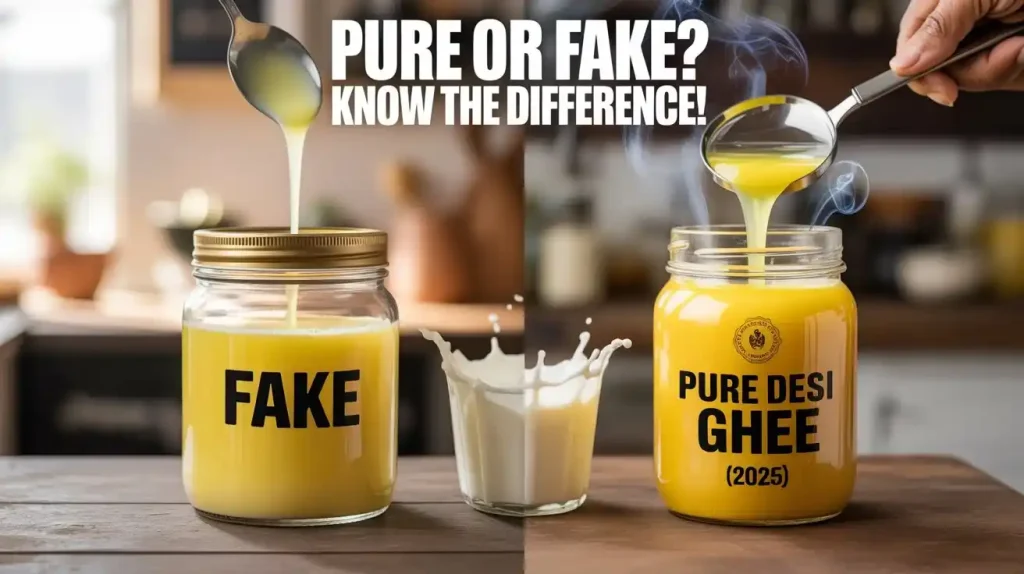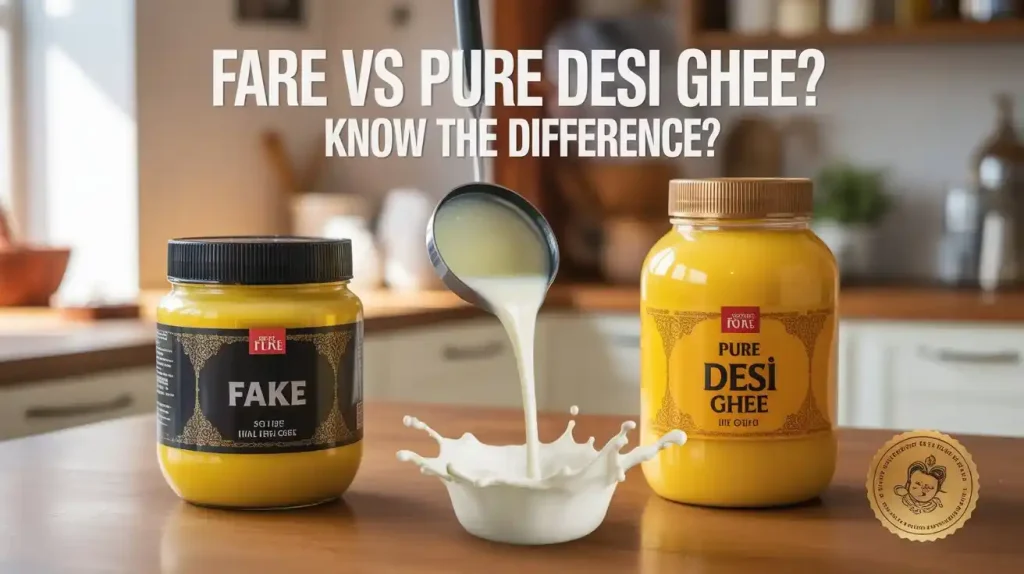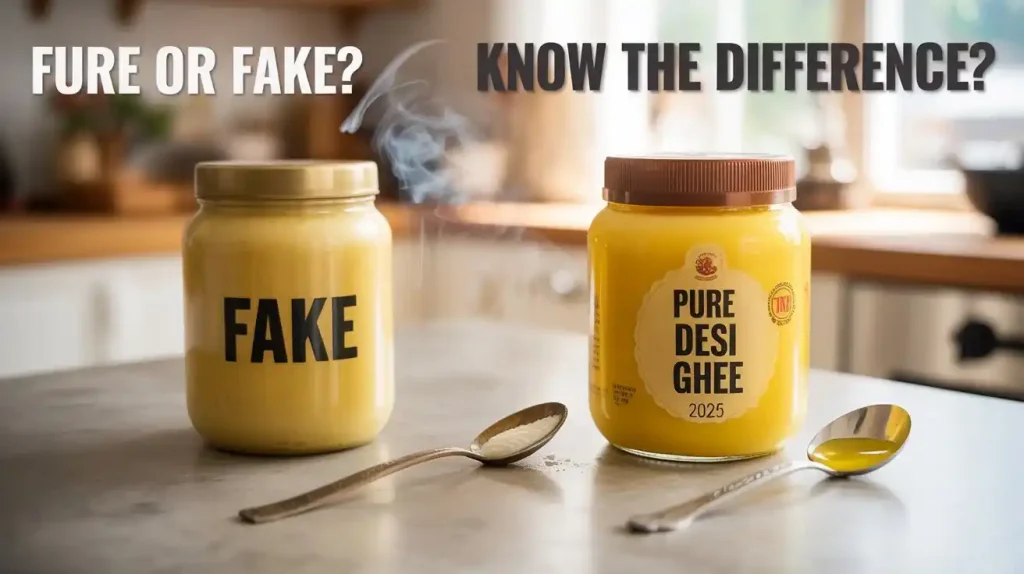
How to Identify Fake vs Pure Desi Ghee Desi ghee is a cherished part of every Pakistani kitchen — known for its rich aroma, golden color, and health benefits. But with the market flooded by low-quality and adulterated versions, identifying pure desi ghee has become a real challenge.
In 2025, the demand for genuine, chemical-free ghee continues to rise, but so does the number of fake products claiming purity. How to Identify Fake vs Pure Desi Ghee guide will help you learn how to detect fake ghee vs pure ghee through simple home tests,How to Identify Fake vs Pure Desi Ghee label checks, and professional tips so you can protect your health and money.
🔍 Why Fake Ghee Exists in the Market
As desi ghee prices continue to rise, some sellers mix cheaper oils and artificial flavors to increase profit margins. These adulterated How to Identify Fake vs Pure Desi Ghee may look and smell similar but lack the nutrients and natural fats found in authentic ghee.
Common adulterants include:
- Vegetable oils (palm oil, vanaspati)
- Artificial butter flavoring
- Coloring agents to mimic the golden hue
- Preservatives and synthetic fat compounds
Consuming fake ghee regularly can cause digestive issues How to Identify Fake vs Pure Desi Ghee , heart risks, and even liver damage.
🧪 The Aroma Test — Follow Your Nose
Pure desi ghee made from cow or buffalo milk has a distinct, pleasant, and nutty aroma.
When heated, it releases a sweet, buttery fragrance —How to Identify Fake vs Pure Desi Ghee unlike fake ghee which smells greasy or synthetic.
👉 Tip: If the smell feels artificial or chemical-like, it’s likely fake.
🔥 The Heating Test — Observe Its Behavior
When you heat pure desi ghee, it melts quickly and turns transparent with a light golden hue.
Fake ghee often leaves a white or sticky residue and may foam excessively.
How to test:
- Heat one spoon of ghee in a steel bowl.
- Pure ghee will become clear and give off a natural aroma.
- Fake ghee may smoke, burn, or give an unpleasant odor.
💧 The Water Test — Simple and Quick
A traditional method to check purity:
- Take a spoon of How to Identify Fake vs Pure Desi Ghee and pour it into a glass of cold water.
- Pure ghee will settle at the bottom without mixing.
- Fake ghee, especially those mixed with oils, will spread or float on the surface.
❄️ The Fridge Test — Check for Texture
Refrigerate a small amount of ghee for one hour.
- Pure cow ghee solidifies uniformly and becomes grainy.
- Fake ghee either remains semi-liquid or freezes unevenly due to added oils.
This is one of the most reliable home tests.
⚗️ The Iodine Test — Scientific Accuracy
You can perform this quick lab-style test at home:
- Add a few drops of iodine solution to a teaspoon of melted ghee.
- If the color changes to blue or purple, it indicates starch or adulteration.
- No color change = pure ghee.
(Handle iodine carefully and use in a small quantity.)
🧴 The Palm Rub Test — Detect Artificial Additives
Take a small amount of ghee and rub it between your palms.
- Pure ghee will melt quickly with no stickiness, leaving only a mild buttery aroma.
- Fake ghee feels oily or sticky, with a chemical smell that lingers.
🧾 Check the Label — Look for Transparency
When buying packaged ghee in 2025, pay attention to labeling.
What to look for:
- “100% Pure Desi Ghee” (with no mention of “blended” or “vanaspati”)
- FSSAI / PSQCA certification (for verified brands)
- Ingredients list — should mention only milk fat
- Manufacturing & expiry dates clearly printed
- Packaging — avoid loose ghee sold without labeling or seal

🐄 Know the Source — Cow vs Buffalo Ghee
Authentic v can come from either cow or buffalo milk, but they differ slightly:
| Type | Color | Aroma | Fat Texture |
| Cow Ghee | Light golden | Sweet & mild | Soft, grainy |
| Buffalo Ghee | Deep yellow | Strong aroma | Thicker & creamier |
Fake ghee often fails to maintain this natural texture or aroma, appearing overly glossy or uniform.
📉 Observe Shelf Behavior — Long-Term Purity Check
How to Identify Fake vs Pure Desi Ghee can last months without spoilage due to its natural fats.
Fake or mixed ghee tends to develop a foul odor or change color over time.
Store your ghee in a cool, dark place and monitor consistency — if it turns watery or sticky, it’s likely impure.
🧠 Buy From Trusted Brands or Dairy Farms
In Pakistan’s 2025 market, reliable names like Nurpur, Adam’s, Olper’s, and Dairyland offer quality assurance and batch testing.
For unbranded options, prefer verified organic dairy farms that sell fresh cow ghee directly. Always check for customer reviews before purchasing online.
🩺 Health Risks of Consuming Fake Ghee
Fake or adulterated ghee can cause:
- Increased cholesterol due to trans fats
- Digestive discomfort and acidity
- Fatty liver or heart strain from hydrogenated oils
- Reduced immunity due to loss of natural vitamins (A, D, E, K)
Pure desi ghee, when consumed moderately, is a source of good fats that support heart, joint, and skin health.
💡 Expert Tip: How to Make Sure You’re Buying Genuine Ghee
If in doubt, buy ghee How to Identify Fake vs Pure Desi Ghee in small quantities first and test it at home using two or more methods above.
Also, compare smell, color, and melting behavior between brands to recognize authenticity over time.
🌟 Conclusion
With rising prices and fake products flooding the market, knowing how to identify pure vs fake desi ghee is essential. By combining simple home tests, v careful observation, and brand awareness, How to Identify Fake vs Pure Desi Ghee you can protect both your health and wallet.

Pure desi ghee not only enhances flavor but also preserves tradition and nutrition. Choose wisely, buy smartly, and enjoy the real essence of Pakistan’s golden delight.
FAQs How to Identify Fake vs Pure Desi Ghee
1. How can I identify pure desi ghee at home?
You can test by heating —How to Identify Fake vs Pure Desi Ghee melts clear and aromatic, while fake ghee smells oily or artificial.
2. What color is pure desi ghee?
Pure cow ghee is light golden, while buffalo ghee is deeper yellow — both have natural tones, not bright or shiny.
3. Does pure ghee solidify in winter?
Yes, genuine ghee hardens slightly in cold weather and melts quickly at room temperature.
4. How does fake ghee differ in smell?
Fake ghee often has a chemical or greasy odor, unlike pure ghee’s nutty, buttery aroma.
5. Is branded ghee always pure?
Not always — check certifications, ingredients, and labels to ensure it’s 100% milk fat.
6. What’s the easiest home test for fake ghee?
The water test — pure ghee settles at the bottom, while fake ghee floats or spreads.
7. Why is fake ghee harmful?
Fake ghee contains artificial fats that can cause cholesterol imbalance and digestive issues
